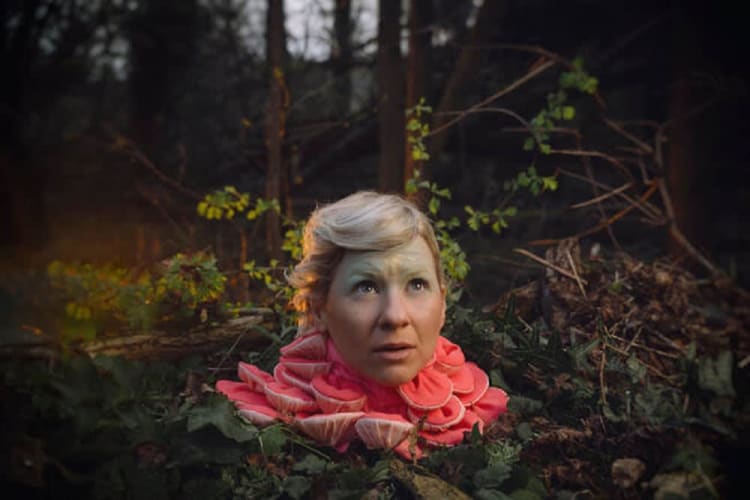As Mushroom Language: A Fungal Gothic is absurdist in nature and opens on a barren wasteland with bare trees and just two characters, comparison with Waiting for Godot may be inevitable. However, as the characters may be abandoned children (or possibly articulate fungi—it’s that sort of play), the legend of Hansel and Gretel may be an influence. As with much else about this highly original play, it is hard to be sure.
Mushroom Language: A Fungal Gothic is reminiscent of the plays which, pre-austerity, might tour schools to raise awareness of historical or social incidents by way of re-enactments rather than displays and lectures. There is an ecological theme to the play but, in the manner of Horrible Histories, rather than condemn the impact of humanity upon nature, it gleefully concentrates on how the unpleasant business of decomposition and rotting helps to promote a cycle of rebirth after death.
The two characters (Ali Matthews and Tom Halls, who also devised the play) are caught up in a series of events which they may have already experienced in the past or in past lives. They share stories and personal experiences which illustrate how the cycle of death and rebirth is part of nature. There is a narrative arc involving a Crow which ominously speaks of an apocalyptic event known as The Rising or The Sap Rising, but to be honest, I rather lost the thread of that plotline (there is a lot going on). Other prophesied events are easier to explain—the litany of half above, half below refers to the roots and branches of trees which, respectively, grow below, and sway over, the earth.
The set, designed by Rūta Irbīte, achieves wonders on a very limited budget. Discarded tights are used to show how the symbiotic relationship between a fungus and an alga form lichen. A sea of plastic sacks provides a means of burrowing underground. The ominous skeleton-shaped branches on the stark trees are snapped off and put to macabre use.
Despite the absurd nature of the presentation, Matthews and Halls never tip the wink to the audience it is acceptable to laugh. Thus, the audience sits in polite silence through scenes which become increasingly ridiculous. The distribution of spoors is illustrated by Halls greedily stuffing dolls into a bag which is crammed onto his head and bursts, scattering the ‘spoors’ around the stage. The manner in which Halls, draped in concealing dark material, shows how truffles are detected by smell leaves little to the imagination.
Finally, Matthews’s enactment of how a stinkhorn fungus reproduces is so completely over the top it is impossible to hold back laughter. The process involves strapping on a massive phallus and the use of a disturbingly large number of tennis balls to represent sperm in a wonderfully grotesque sequence.
Mushroom Language: A Fungal Gothic glories in the more distasteful aspect of nature—the smell of rot, the creepy fact plants grow out of dead, decomposing things. The play allows for a rueful reflective conclusion as the characters prepare to begin the process of rebirth being wiser than when they started. The deliberately obscure nature of the show limits the extent to which one can conclude it is a play of high quality, but it is certainly a one worth seeing to make up your own mind.
